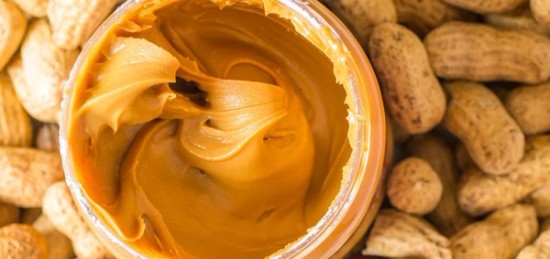By Caroline Young Bearden, MS, RD, LD, RYT
As a registered dietitian, I often get asked if peanut butter is good for you, or if there’s a peanut butter that’s better than others. Have you ever wondered if your favorite PB is good for you? Well, I broke down the nutrition facts and ingredients lists to help answer that question.

The Skinny on Fat
At first glance at a peanut butter nutrition facts label, you may think there’s a lot of fat. And you’re right, there is. As you can see, about one-fourth of your body’s daily need for fat is met in one serving size (two tablespoons) of peanut butter, and more than 65% of the calories (130 out of 190) come from that fat. But look closely and you’ll see that just 2.5 grams (or 15%) of the overall fat in a serving of peanut butter is from saturated fat, the type of fat that the Dietary Guidelines for Americans recommend we limit. The rest of the fat comes from good, unsaturated fats, which can help lower risk of heart disease and improve HDL cholesterol levels.
And remember: Fat is important! You need fat for your body to function properly, including to give you energy and help you absorb essential vitamins[i, ii, iii].
You’ll also notice that peanut butter has zero grams of trans fats, which come from partially hydrogenated oils (PHOs). That’s in part due to the FDA’s 2015 determination that PHOs are no longer safe to eat since they have been linked to an increased risk of heart disease. Since then, the majority of peanut butters on the market do not contain PHOs [iv].
But that doesn’t mean the fully hydrogenated vegetable oils, like rapeseed and soybean (as seen on the JIF label) are harmful, too. In fact, these oils do not contain trans-fat but serve a similar purpose as PHOs, including reducing rancidity (and increasing shelf-life) and preventing oil separation. Another common oil used in peanut butters is palm oil, which contains saturated fat but not trans-fat. To put it into perspective, oils take up 1 to 2% of the peanut butter’s overall weight.
The Other Nutrition Facts
As you can see, peanut butter packs 7 grams of protein and 2 grams of dietary fiber per serving. Protein is necessary for the health of your bones, muscles, cartilage, skin and blood, and fiber plays a key role in important bodily functions like digestion. Plus, as you can see towards the bottom of the label, peanut butter is a source of essential vitamins and minerals.
On some peanut butter labels, you will see there is some sodium. For example, this peanut butter contains salt (last on the ingredient list) and the nutrition facts label has 130 mg of sodium, which makes up only 6% of the recommended daily value of sodium.
Common PB Ingredients
Along with salt, sugar is sometimes added to peanut butter. Other words to look for on the ingredients list that also mean sugar include molasses, honey, agave syrup and dried cane syrup. In this label example, there are 3 grams of sugar, which is about 12 calories. The Dietary Guidelines recommend that no more than 10% of daily calories come from added sugars.
Aside from salt and sugar, there are very few other additives that you’ll spot on the ingredient list. If you’re into globally-inspired flavored peanut butter, you may see some seasonings like curry powder. Additionally, the use of mono- and diglycerides (as seen on this label) are used in some peanut butter as emulsifiers to prevent oil separation.
On every jar of peanut butter you buy, you’ll see that the very first ingredient is always peanuts because all food ingredients are listed by weight in descending order. And the FDA says that the percentage of peanuts in peanut butter should not fall below 90%. Regardless of whether you buy natural peanut butter, unsalted peanut butter or chocolate peanut butter, you can be sure that the majority of your jar is just peanuts [v].
And peanuts have more protein than any nut (7 grams per ounce), fiber, good fats and other essential nutrients.
Bottom Line
The good news is that there is a type of peanut butter for every person, every mood and every occasion. And there’s more good news -- whether you go for the natural peanut butter made with just peanuts, or that decadent chocolate chip cookie dough peanut butter, you’ll still get your good fats, protein, fiber and other essential nutrients.
References
[i] The Skinny on Fat: The Good, the Bad, and the Unknown. NIH News in Health. https://newsinhealth.nih.gov/2019/03/skinny-fat. Updated March 2019. Accessed October 25, 2023.
[ii] More Key Topics. Choose My Plate. https://www.myplate.gov/eat-healthy/more-key-topics. Accessed October 25, 2023.
[iii] Dietary Fats. Medline Plus. https://medlineplus.gov/dietaryfats.html. Updated April 21, 2017. Accessed May 9, 2017.
[iv] Final Determination Regarding Partially Hydrogenated Oils (Removing Trans Fat). U.S. Food and Drug Administration. https://www.fda.gov/food/food-additives-petitions/final-determination-regarding-partially-hydrogenated-oils-removing-trans-fat. Updated May 18, 2018. Accessed October 25, 2023.
[v] Food Standard Innovations: Peanut Butter's Sticky Standard. U.S. Food and Drug Administration. https://www.fda.gov/about-fda/histories-product-regulation/food-standard-innovations-peanut-butters-sticky-standard. Updated January 31, 2018. Accessed October 25, 2023.
